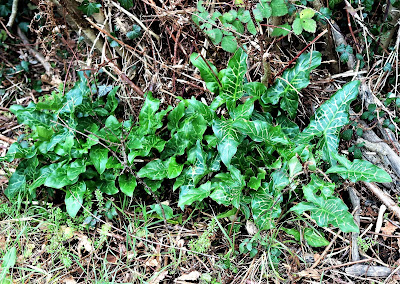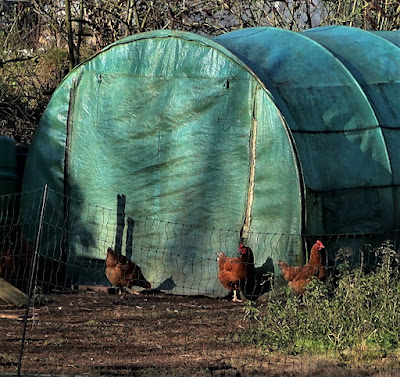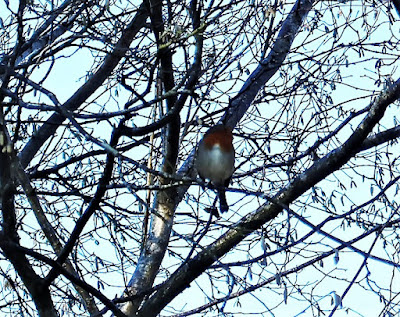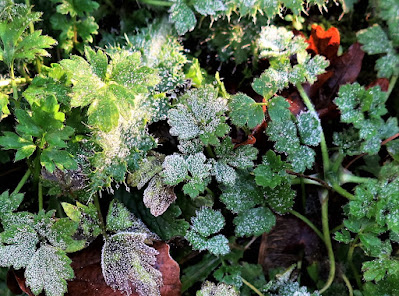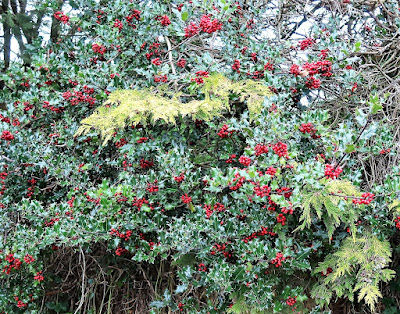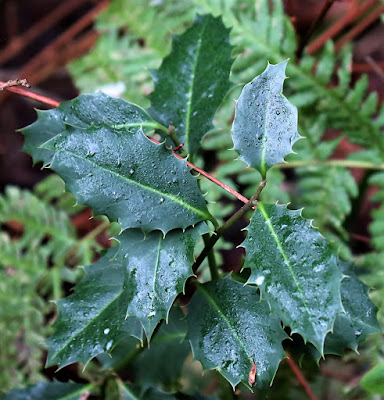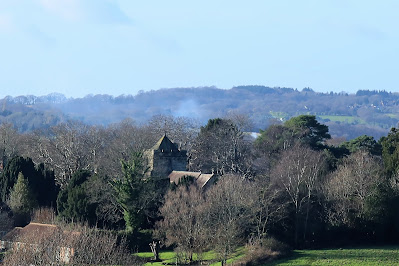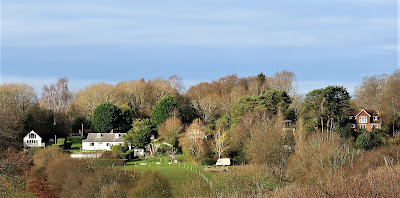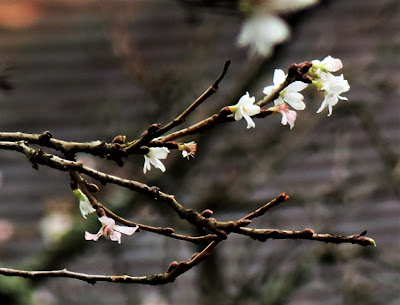31 January 2022 The end of a cold, dry month though with few frosts, all of them light. The lack of any significant rain for many days is, I think, affecting wildlife locally. Hazel catkins seem slower to expand, I have seen no celandine flowers, fallen leaves remain on the woodland floor like a fluffy, dry eiderdown. Still, there have been plenty of things to see and record.
We have several mahonias in the garden and these provide nectar rich flowers from November to February inclusive. One of the most magnificent is Mahonia x media 'Buckland' which flowers right through December and January.
Rather more modest but still an attractive plant is Mahonia japonica which flowers here from late January through March. It often attracts bumble and honey bees and blue tits raid the flowers for nectar, or I assume this is what they are finding.
A bit further south I found a small, self-sown bay tree (Laurus nobilis)a species not common in the wild. The leaves resemble laurustinus, which grows not far away, but the smell of the bay gives it away
 |
17 January 2022 Cold nights but sunny and cool days. A badger has been digging for worms in the newly exposed stretch of verge alongside Churchland Lane
The hazel catkins in the picture above mostly are closed, though higher up the bush they are starting to open (see below), while on the opposite side of the lane, in another bush, they are fully open.
14 January 2022
A sharp frost overnight whitened the grass in Churchland Fields and covered creeping buttercup leaves in my second Square Metre with Ice crystals like a scattering of sugar.
I noted two leaf mines in a frosted bramble leaf halfway down the garden. I am pretty sure these have been made by the larvae of the tiny moth Stigmella aurella (there are some similar species that mine bramble leaves). The larvae and pupae can survive frosts and, if occupied mines are brought indoors and kept in a jam jar, the moths like sooty, black sparklets will emerge often quite quickly.
One of my favourite books Birds and Berries by Barbara and David Snow (T & A D Poyser, 1988) says that black bryony berries are eaten, usually after they have been on the vine for some time, by blackbirds and thrushes, though robins will occasionally tackle them though they are rather too large to swallow in one go.
Black bryony berries (below) are toxic to humans but perhaps simply rather unpalatable to birds. The problems with humans and, presumably with other mammals, is that the berries (and root tubers) are full of calcium oxalate that forms tiny needle-sharp crystals that can penetrate skin and cell walls causing irritation which can be dangerous internally.
Two hollies in particular have caught my eye this autumn and winter . One was an example, probably of garden origin, with an exceptionally rich crop of berries hanging over a fence in Broad Oak Brede (below).
The other is a young plant on the fringe of my Square Metre project where it has been bird-sown from the overhanging medlar tree (see below). It looks like a form of Highclere holly, Ilex x altaclerensis, Judging by the shape and texture of the leaves and the prickles it is probably a hybrid between a garden form of Highclere holly and our native species, what is known as introgressive hybridisation. The I. x altaclerensis of horticulture is a hybrid between Ilex perado (probably from Madeira) and our native species. It is widely planted in gardens usually as a variegated clone with almost or completely spineless leaves.
10 January 2022
8 January 2022 Cold, hard rain all day and all night. I didn't venture forth. Instead I took this picture, blurred with rain, through the French windows out into the patch of garden I spend much of each day contemplating.
I wondered where the birds I usually see were sheltering. The commonest species (I don't have bird feeders) are blackbirds, hedge sparrows, wrens, robins, thrushes, wood pigeons and magpies. All the finches, except that occasional goldfinches and bullfinches, have disappeared and, of course, there are buzzards and things flying overhead that I cannot see. Indeed when the windows are covered with raindrops and my glasses are dirty I cannot see very much at all. It's cold indoors too.
6 January 2022 A sharp overnight frost leaving a white sheen over the lawn and silvered fallen leaves on the wooden ramp outside my window.
The terminal leaves of the spurge Euphorbia amygdaloides ssp. robbiae (Mrs Robb's bonnet) start to expand, in their bent over way, at this time of the year like narrow hop cones and contrasting with the old, darker green foliage. In a few weeks they will have grown into flower heads. This is one of the earliest signs that things are starting to move towards spring.
5 January 2022 A sunny, mild morning. In the hedge on the eastern side of the lane I found a single plant of Berberis darwinii. Though not very obvious, I was surprised at the number of times I must have walked past it without noticing it.
We have a very active thrush, perhaps a pair, in the garden that looks as though they will soon be starting to build a nest.
3 January 2022 A change of walking route took me right to the end of Churchland Lane (nearly half a kilometre from home). A few metres up Hurst Lane, in the front garden of Tresco, I stopped to look at the fragile blossoms on the winter flowering cherry, Prunus x subhirtella 'Autumnalis Rosea'.
New Year’s Day, 1 January 2022
Must get more done this year.
On the western side of Churchland Lane there is a 30 metre stretch of verge that has been cleared right back to the hedge. This has left a 2 metre wide stretch of somewhat disturbed, dark and rich looking soil with a variety of low growing plants and the saw-shattered stumps of young trees and shrubs. A distinctive feature on New Year’s Day was the many shiny green tufts of emerging Arum maculatum, cuckoopint, leaves perhaps a hint that this newly uncovered section of this verge will reveal much of interest in coming months.
In the garden the pink, single camellia (Camellia × williamsii 'J.C. Williams') always the first, has started flowering. My late wife used to refer to this as "her camellia", though there were many more varieties in the garden. I assume it was because she could see it from the kitchen window. The wintersweet (Chimonanthus praecox, là méi) in the flowerbed where the old shed used to stand is in full flower and casting its powerful scent on the air on milder days. This year it has perhaps the best display I have seen but the blossoms turn to a dowdy speckled yellow if there is much frost (so far this winter we have had only one or two nights of light frost and today the temperature reached 14°C, very high for the time of year).
Killingan Wood was calm and damp, a silent army of grey
trunked hornbeam trees, with a carpet of decaying fallen leaves braided by
muddy tracks.
On my walk I saw very few insects. Over most of my life warm
winter days like this have seen numerous small swarms of many insect species that are adapted
to flying only in the winter months. But they seem to have gone.
This will affect birds and spiders as well as the many small creatures that
must have fed on their fallen bodies and earlier stages. The consequences for biodiversity
are unknown.
Many writers reflect on the decline of the cuckoo, or the pearl
bordered fritillary, but this morning I would like to pay homage to an absent
friend: Gymnometriocnemus brumalis a winter flying, non-biting midge.
Maybe, if we have a cold spell, there will be a belated
emergence, but I hope 2022 will not be the year when we have to say goodbye to
this small winter flying insect.





